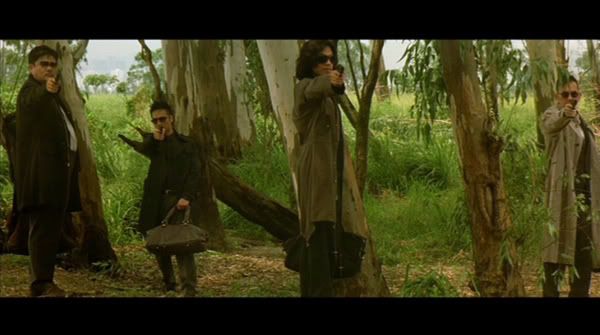
Johnnie To’s highly mannered, yet sufficiently bullet riddled gangster film tests two of the genre’s most important moral qualities: the importance of friendship vs. the bonds of loyalty. When an ex-member, banished from his home town for attempting to murder his mob boss decides to return home to raise his son, two of his best friends and former colleagues are sent to kill him, while two other friends vow to protect him. It’s a simple, ingenious concept that finds its characters – in between superbly choreographed gunfights – weighing their debts to gang fidelity.
There is a remarkable sequence early in the film in which the protectors and the assassins share cigars together in an unspoken professional understanding, while they await their mark to arrive. Once he does, they allow him to go up to his apartment and each side then sends one of their own upstairs after him. Just before they get down to business, they quietly ensure each man has the same amount of bullets. A violent three-way battle unfolds between the three men, leaving the apartment in near shambles, but when they all run out of ammunition, they simply stop, call in their associates, help the target move into the apartment and have dinner together. Eventually, the assassins and protectors agree that they can’t go through with killing each other or their mark, and vow to work together on some contract killings to get their friend out of town, with enough finances to raise his family.
From here, To sets up a familiar supporting framework. There’s a hooker looking to grab one big score, a cop on the verge of retirement and an absolutely psycho mob boss with a thirst for blood and money. Nevertheless, To’s mastery of the material keeps it from getting stale. It is a pure joy, coupled with some genuine surprises, watching the machinations of the plot click into place like a fine Swiss watch. As the film builds towards its monumental finale, To patiently and thoroughly weaves each strand of the plot into a perfect knot.
It’s rare to watch a film of this nature that treats the entire subject with near existentialism. Tonally, the film evokes the classic French gangster films of Jules Dassin or Jean-Pierre Melville. Behind the camera, To eschews realism for something more painterly. The film contains about four major action sequences, and each one is as carefully realized as the next, with the kind of balletic, yet over-the-top gunplay that John Woo excelled at in his pre-Hollywood days. Even the special effects defy reality as blood explodes in perfume-like puffs of mist rather than thick red streams. For the final sequence, To constructs a hotel set that cuts away the ceilings so he can shoot directly over the action, literally displaying the architecture of his shots.
Whereas American action films continue to aspire to bigger explosions and endless ammunition, To’s film is a exciting breath of fresh air. It makes every bullet, every movement and every word count, making it that much more exciting when the triggers are finally pulled and bodies are hurled almost angelically through the air.



No comments:
Post a Comment